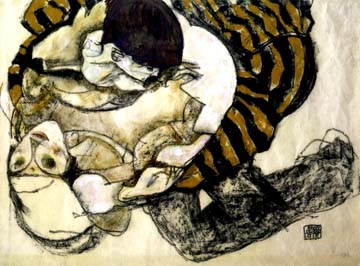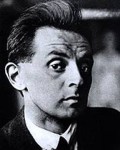
Egon Schiele
Austrian, 1890-1918
The Embrace, 1915
gouache, charcoal, and black crayon
12 3/4 x 17 3/4 in.
SBMA, Bequest of Margaret Malory to Ala Story Collection
1998.50.78

Undated photograph of Schiele in his twenties.
RESEARCH PAPER
Egon Schiele (1890-1918) was one of the great Austrian artists of the twentieth century. Schiele was barely 20 years old when he executed his breakthrough Expressionist style. His work is powerful, shocking and emotionally intense. A superb draftsman and colorist, his figurative work is often raw, sexual and challenging.
The Embrace (Lovers) by Egon Schiele is a mixed media gouache, charcoal and black crayon drawing. This piece, part of the CoupleSeries, was done in 1915, the year that Schiele married and three years before his untimely death in 1918 at age 28.
The woman in our drawing is Edith Schiele, his wife. She is wearing a striped dress and peaked turban, an outfit Schiele often paints Edith wearing. The male in this series of studies sometimes resembles Paul Erdmann (Edith’s nephew), and sometimes Schiele. In our picture the male is most likely the boy, Paul. The couple is in a circular composition, with the female, Edith, upside down and looking straight at the viewer. The boy, Paul, is wrapped in her embrace, as if in a cocoon with his head to the side. He appears peaceful and at rest. We have an aerial view of the couple. It is as though we are peering down a spiraling staircase at two frolicking, rolling figures.
Intertwining figures is a motif often used by Schiele. Again and again we see couples in a circular composition, often erotic and sexual, with naked bodies in various states of undress. In some cases the couple is a double self- portrait of Schiele himself looking point blank at the viewer. This is often the point-of-view of Schiele’s figures – confrontational and direct – as though being interrupted in a private moment and challenging the viewer. The viewer or spectator becomes “a voyeur.”
Drawings of couples assumed special prominence in 1915, the year of our picture and the year of Schiele’s marriage. His work was less harsh and sexually explicit for a time, and at Edith’s request, Schiele gave up professional models. The only erotic drawings in 1915 were those of Edith.
The Embrace does not have the sexual tension and rage prevalent in so much of Schiele’s work. There is playfulness in the twisting figures. The colors are muted and the soft black crayon, black charcoal and orange, red and yellowish gouache create a pleasant image. The intense fauve colors of some of Schiele’s earlier work are not present in The Embrace.
Expressionism
Expressionism refers to an art movement that uses distortion, exaggerated forms, abstraction, alienation and strong colors for emotional impact. Expressionism dominated German art from 1905-1930. This emotional style, which is the foundation of much twentieth century art, began with Van Gogh, Gauguin, and Munch in the late nineteenth century and continued with Belgian painter James Ensor, and Austrian painters Gustave Klimt, Egon Schiele and Oscar Kokoschka. It was in Germany, with two separate groups called Die Brucke and Der Blaue Reiter, that Expressionism reached maturity.
Like other expressionist artists Schiele used his own experiences as the basis for his art. Sexual issues were central to his work. He was a young man just past adolescence with all of the sexual energy and angst of his age. His subjects, the everyday people of Vienna, models, friends and family, were often portrayed in an erotic manner and conveyed raw emotion.
Vienna in the early days of the 20th Century had a stimulating artistic and intellectual climate. Psychoanalysis was being introduced, and sexuality was a hot topic. As Klaus Schroder says in his book Egon Schiele Eros and Passion “From psychoanalysis by way of medicine to art, minds everywhere were concentrated on sex, whether with a view to its suppression or its emancipation…there was a demand for erotic pictures.”1. Added to this was a feeling of anxiety and apprehension due to the threat of war, and in fact the beginning of World War I does come on July 28, 1914 when Austria-Hungary declared war on Serbia.
Biography
Egon Schiele was born on June 12, 1890, at Tulln, a small town in lower Austria. Schiele’s father, Adolf Schiele was a railroad controller. He and his wife Marie had six children. Only three survived infancy and Schiele grew up with his older sister Melanie, and younger sister Gertrude, whom he often used as a model.
Schiele demonstrated artistic talent at an early age and received classical training at the Academy of Fine Arts (Akademie der Bildenden Kunst) in Vienna. In 1907, when Schiele was 17 years old he met Gustave Klimt. Klimt had founded the Vienna Secession in 1897, breaking away from the established art group “the Kunstlerhaus.” Like the Paris Salon, the Kunstlerhaus could exclude artists from exhibiting, and had great influence on the art market. Like the Impressionists, Secession artists wanted independent exhibitions and control over their artistic careers. Their style combined flat, decorative imagery with subtle, often strong use of color.
When Egon Schiele entered the art scene in Vienna, Klimt was the undisputed central figure. Schiele’s early work is reminiscent of Klimt’s Art Nouveau (Jugendstil) style and in 1909 four works by Schiele were included in the Viennese International Art Show (International Kunstschau Wien) under the presidency of Klimt; all four works showed a strong affinity with Klimt’s style. Shortly after this time Schiele moved away from decorative Art Nouveau and his emotionally intense work moved towards Expressionism.
In 1911 and 1912 Schiele exhibited regularly to great acclaim, in Budapest, Vienna and in Munich with members of the local group “Der Blaue Reiter.”
At this time Schiele’s burgeoning artistic career was interrupted. His downfall was his habit of asking the neighbor’s children to model for him. When Schiele took in a thirteen year old girl runaway, the girl’s father accused him of abduction. On April 13, 1912, Schiele was arrested and held in custody. The main count against him, that of seducing a minor, was dropped. But because children had been able to see nude studies in his studio, he was sentenced to three days imprisonment for negligent custody of erotic nude material. In all, Schiele spent twenty-four days in jail. This experience was very traumatic for Schiele and afterwards his work became somewhat tamer and he no longer used child models.
On June 17, 1915, Schiele married Edith Harms. Four days later he was drafted into the army and ordered to Prague. After basic training in Bohemia, he was assigned to Vienna on escort duty for Russian prisoners of war, some of whom he drew. At the end of the year he was invited to exhibit at the Berlin Secession and the Kunstschau in Vienna.
In 1916 Schiele continued to draw, paint and exhibit despite limitations imposed by the war and his duties as a soldier. In 1917 Schiele took part in exhibitions in Vienna, Munich, Amsterdam, Stockholm, and Copenhagen.
On February 6, 1918 Klimt died and Schiele was now recognized as Austria’s leading artist. The 49th exhibition of the Vienna Secession brought him his first major artistic and financial success. His works were also shown with great success in Zurich, Prague and Dresden.
In the last days of the war, Schiele’s wife Edith contracted the deadly Spanish Influenza that was raging all over Europe. She died on Oct. 28; 6 months pregnant. Schiele died 3 days later on October 31, 1918. He was 28 years old.
Schiele had a strong following of patrons and collectors that enabled him to support himself (though not always in grand fashion) throughout his career. In the last three years of his life his work had undergone a profound stylistic change, becoming less harsh and confrontational. Our picture falls into this category. It was this stylistic turnaround that was at least partially responsible for Schiele’s increased success toward the end of his life. He received his most substantial success in 1918 shortly before he died.
Provenance
Our picture The Embrace (Lovers) was donated to the museum by Ala Story who was the second director of the Santa Barbara Museum of Art (1952-1957). Story was born in Austria and studied for five years at the Academy of Fine Arts in Vienna, the same school Schiele attended. After seeing the first retrospective exhibition of Vincent Van Gogh, held at the Vienna Secession in 1928, she felt she didn’t have the talent to become an artist and abandoned her artistic studies. She did, however, have a very successful career in the art world. Ala Story amassed a collection known as “The Ala Story Collection of International Modern Art”, which spans the first 70 years of this century and includes styles such as Post-Impressionism, Fauvism, Cubism, German Expressionism, Constructivism, Futurism, Dada, Surrealism, Synchronism, and Abstract Expressionism. The Embrace is part of this noteworthy collection.
Provenance: Dorotheum, June 11, 1959, sale 544, lot 238; Gallerie St. Etienne, New York; Ala Story.
Prepared for the Santa Barbara Museum of Art Docent Council by
Patricia Goss, January 2006
Notes
1. Schroder, Klaus Albrecht. “EGON SCHIELE EROS AND PASSION.” Pestel, New York, 1999. p. 45.
Bibliography
Kallir, Jane, “EGON SCHIELE LIFE AND WORK.’ N.Y.: Abrams, 1990.
Kallir, Jane, “EGON SCHIELE: THE COMPLETE WORKS, INCLUDING A BIOGRAPHY AND A CATALOG RAISONNE.” N.Y.: Abrams, 1990.
Mitsch, Erwin. “EGON SCHIELE.” N.Y.: Phaidon, 1975.
Santa Barbara Museum of Art. “THE ALA STORY COLLECTION OF INTERNATIONAL MODERN ART.” Santa Barbara, California, 1984.
Santa Barbara Museum of Art. “TWO COLLECTIONS : MARGARET MALORY – ALA STORY. Santa Barbara, 1966.
Schmidt, Ludwig. “EGON SCHIELE.” Germany. Berghaus, 1966.`
Schroder, Klaus Albrecht, “EGON SCHIELE: Eros and Passion.” Munich. Prestel, 1999.
